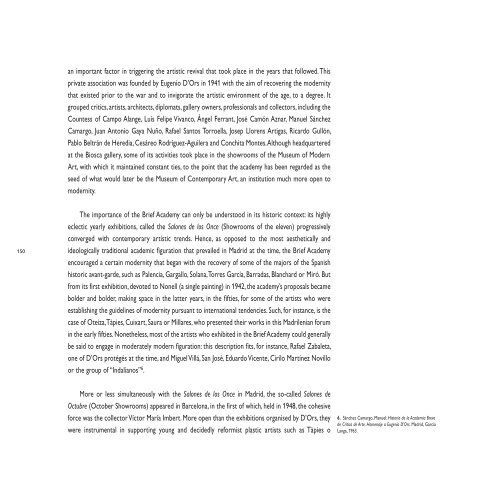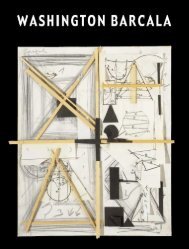VERSIÓN INGLESA ENGLISH VERSION - Fundación César Manrique
VERSIÓN INGLESA ENGLISH VERSION - Fundación César Manrique
VERSIÓN INGLESA ENGLISH VERSION - Fundación César Manrique
You also want an ePaper? Increase the reach of your titles
YUMPU automatically turns print PDFs into web optimized ePapers that Google loves.
150<br />
an important factor in triggering the artistic revival that took place in the years that followed. This<br />
private association was founded by Eugenio D’Ors in 1941 with the aim of recovering the modernity<br />
that existed prior to the war and to invigorate the artistic environment of the age, to a degree. It<br />
grouped critics, artists, architects, diplomats, gallery owners, professionals and collectors, including the<br />
Countess of Campo Alange, Luis Felipe Vivanco, Ángel Ferrant, José Camón Aznar, Manuel Sánchez<br />
Camargo, Juan Antonio Gaya Nuño, Rafael Santos Torroella, Josep Llorens Artigas, Ricardo Gullón,<br />
Pablo Beltrán de Heredia, Cesáreo Rodríguez-Aguilera and Conchita Montes. Although headquartered<br />
at the Biosca gallery, some of its activities took place in the showrooms of the Museum of Modern<br />
Art, with which it maintained constant ties, to the point that the academy has been regarded as the<br />
seed of what would later be the Museum of Contemporary Art, an institution much more open to<br />
modernity.<br />
The importance of the Brief Academy can only be understood in its historic context: its highly<br />
eclectic yearly exhibitions, called the Salones de los Once (Showrooms of the eleven) progressively<br />
converged with contemporary artistic trends. Hence, as opposed to the most aesthetically and<br />
ideologically traditional academic figuration that prevailed in Madrid at the time, the Brief Academy<br />
encouraged a certain modernity that began with the recovery of some of the majors of the Spanish<br />
historic avant-garde, such as Palencia, Gargallo, Solana, Torres García, Barradas, Blanchard or Miró. But<br />
from its first exhibition, devoted to Nonell (a single painting) in 1942, the academy’s proposals became<br />
bolder and bolder, making space in the latter years, in the fifties, for some of the artists who were<br />
establishing the guidelines of modernity pursuant to international tendencies. Such, for instance, is the<br />
case of Oteiza, Tàpies, Cuixart, Saura or Millares, who presented their works in this Madrilenian forum<br />
in the early fifties. Nonetheless, most of the artists who exhibited in the Brief Academy could generally<br />
be said to engage in moderately modern figuration: this description fits, for instance, Rafael Zabaleta,<br />
one of D’Ors protégés at the time, and Miguel Villá, San José, Eduardo Vicente, Cirilo Martínez Novillo<br />
or the group of “Indalianos” 6 .<br />
More or less simultaneously with the Salones de los Once in Madrid, the so-called Salones de<br />
Octubre (October Showrooms) appeared in Barcelona, in the first of which, held in 1948, the cohesive<br />
force was the collector Víctor María Imbert. More open than the exhibitions organised by D’Ors, they<br />
were instrumental in supporting young and decidedly reformist plastic artists such as Tàpies o<br />
6. Sánchez Camargo, Manuel: Historia de la Academia Breve<br />
de Crítica de Arte. Homenaje a Eugenio D’Ors. Madrid, García<br />
Langa, 1963.
















![Becas y premios de la Fundación César Manrique [1997-2006]](https://img.yumpu.com/20766851/1/184x260/becas-y-premios-de-la-fundacion-cesar-manrique-1997-2006.jpg?quality=85)
